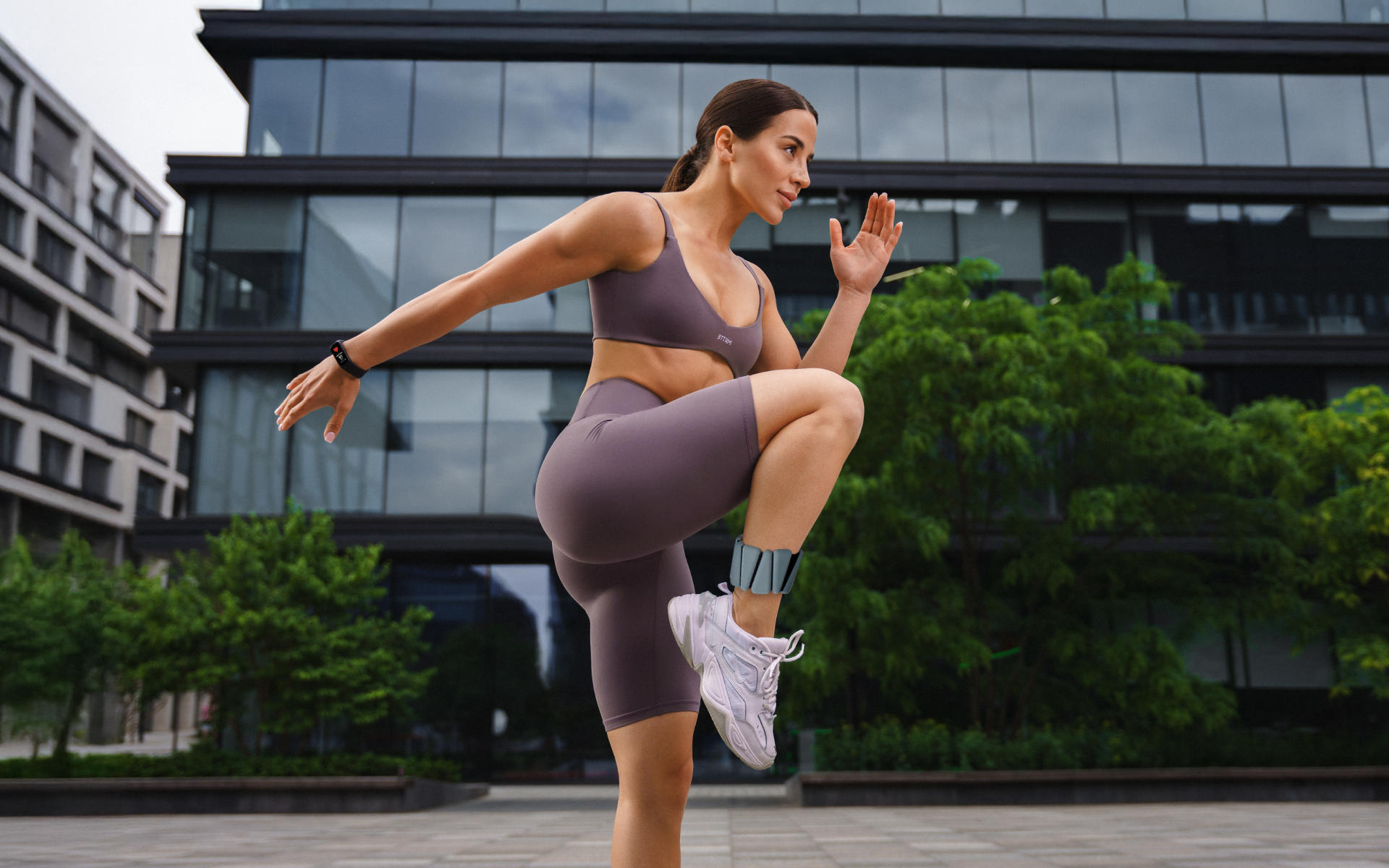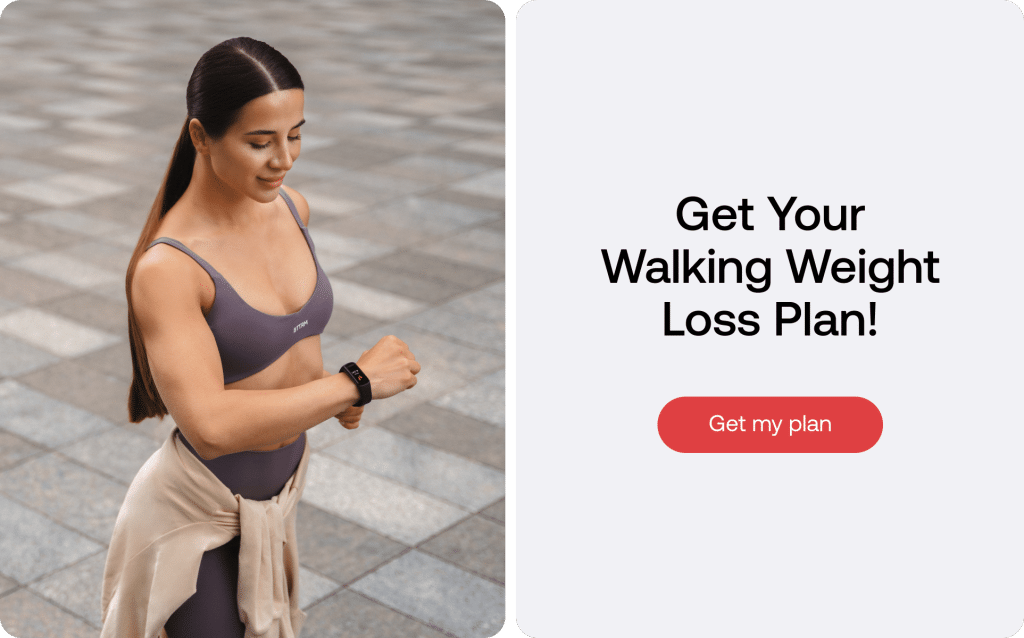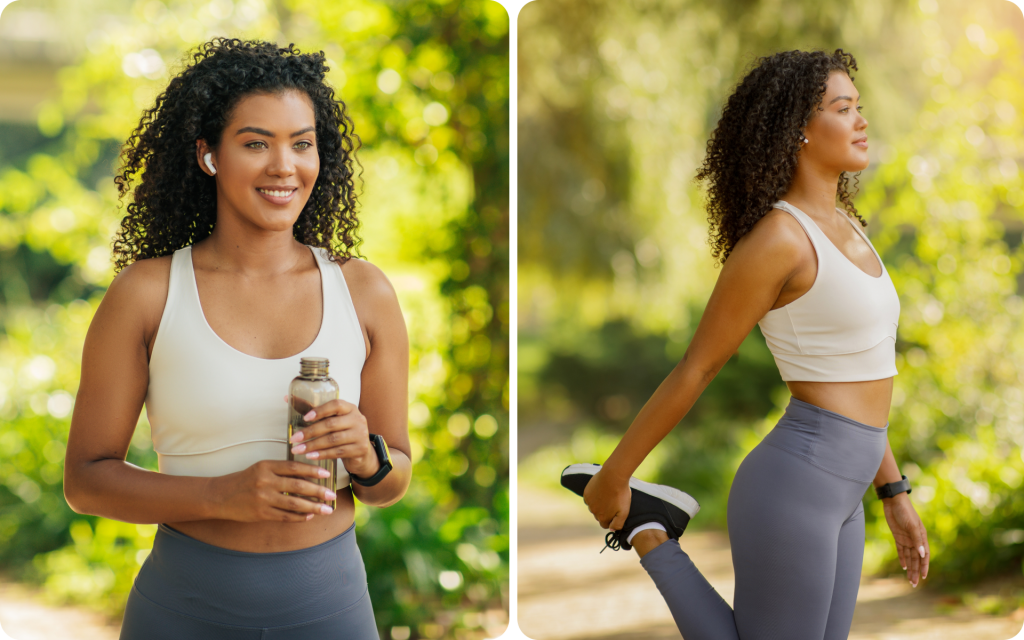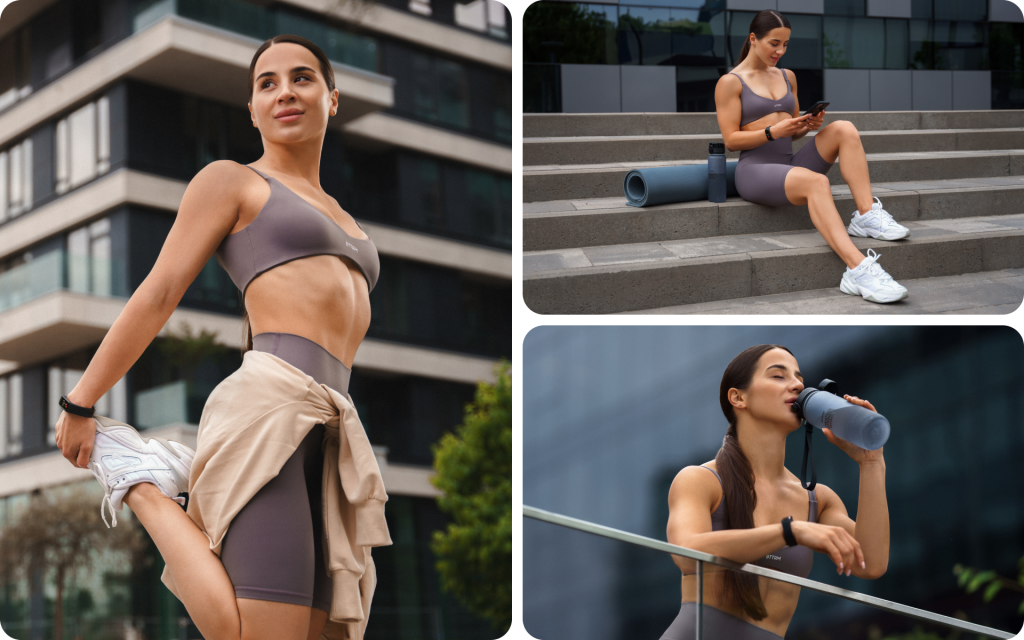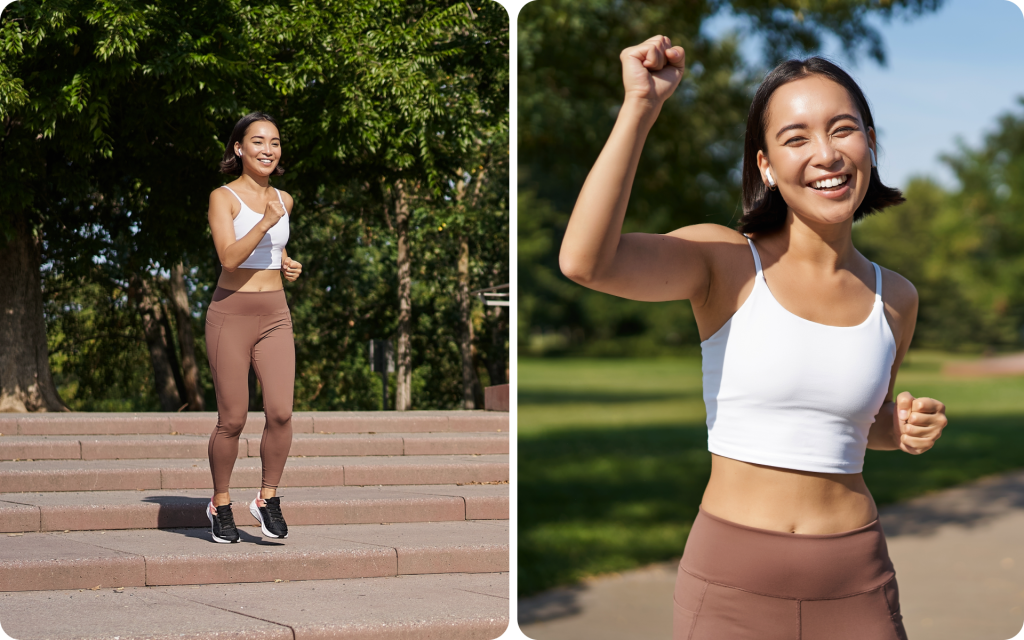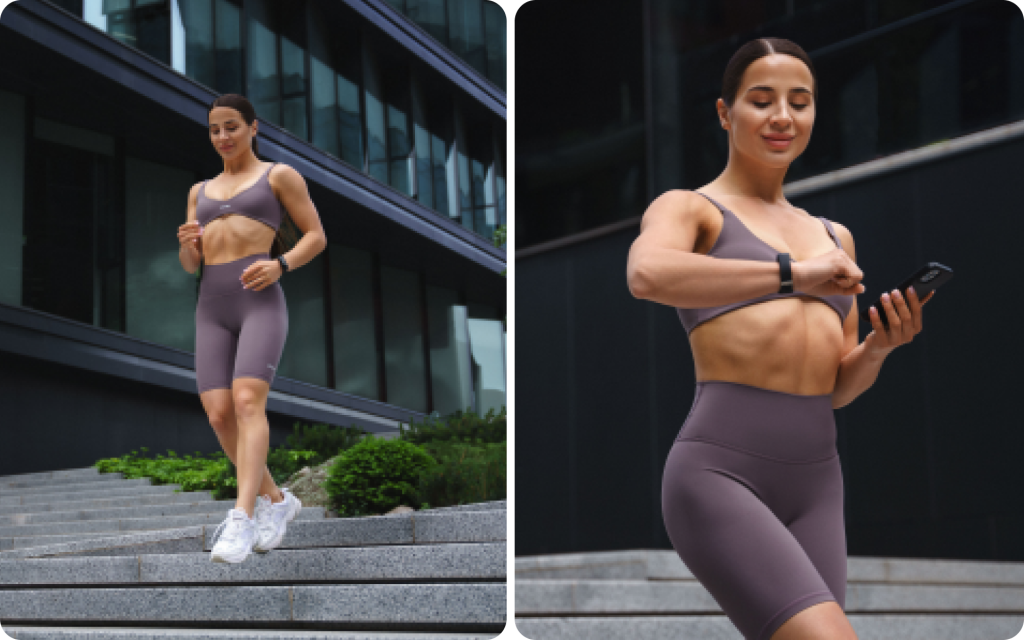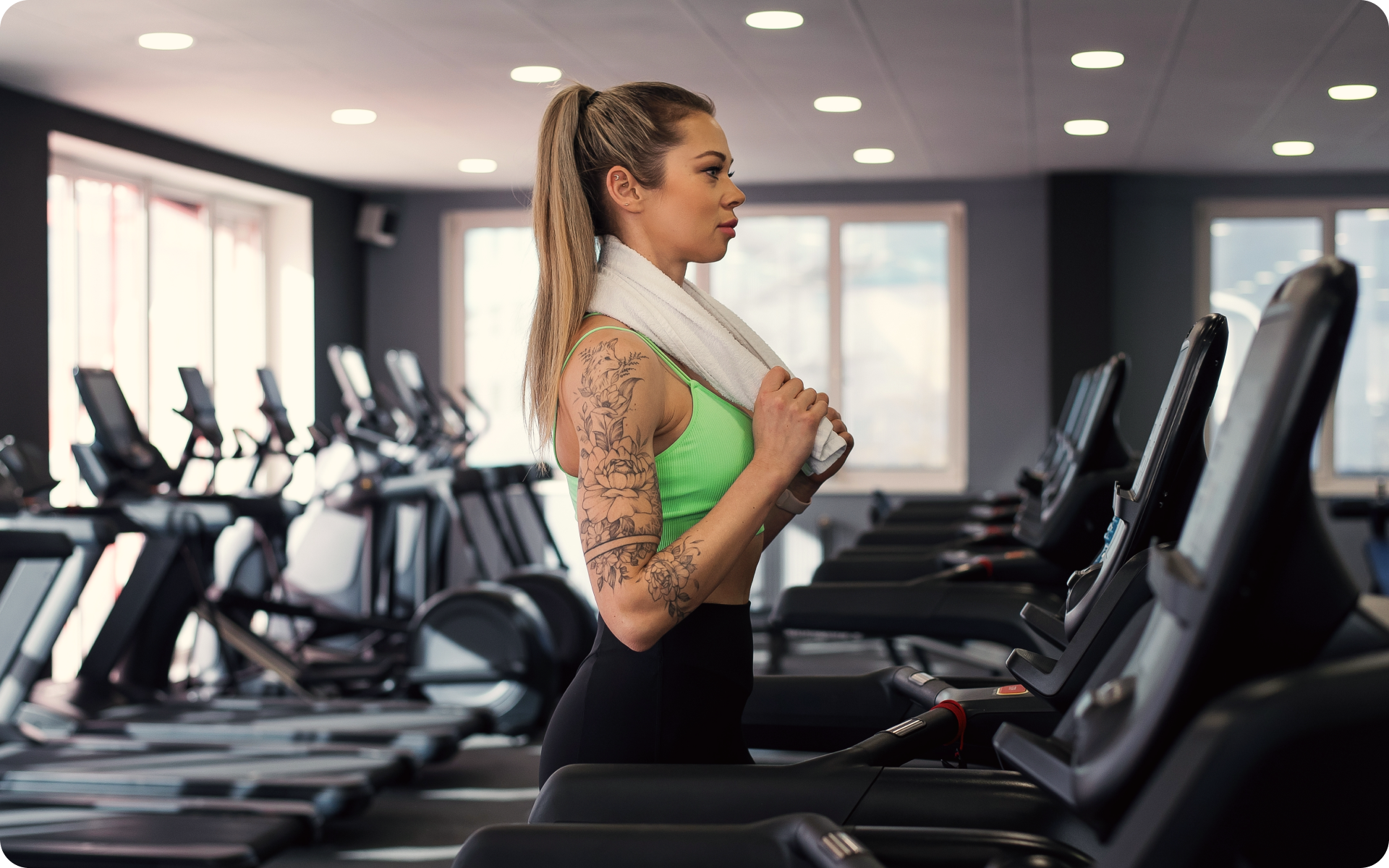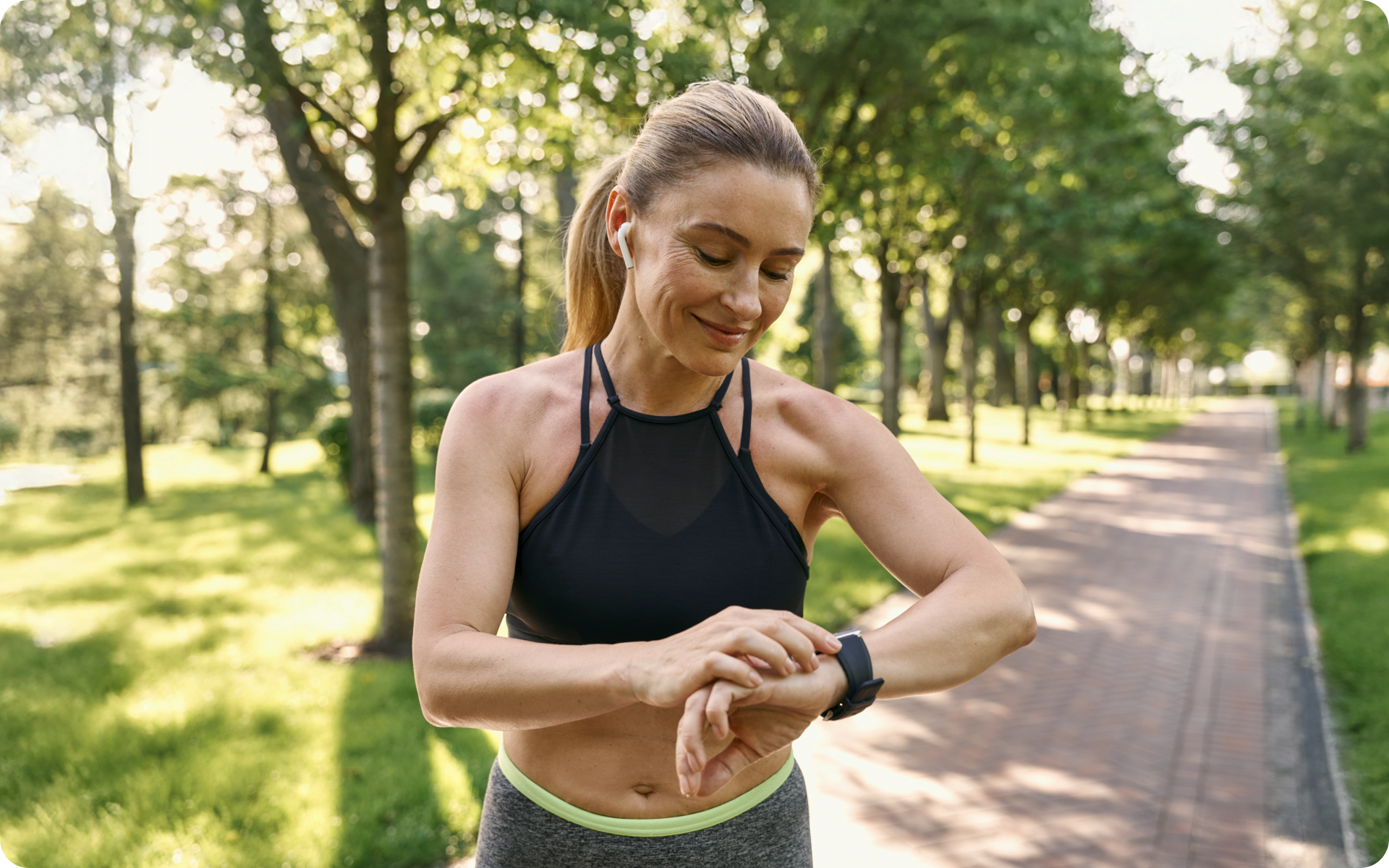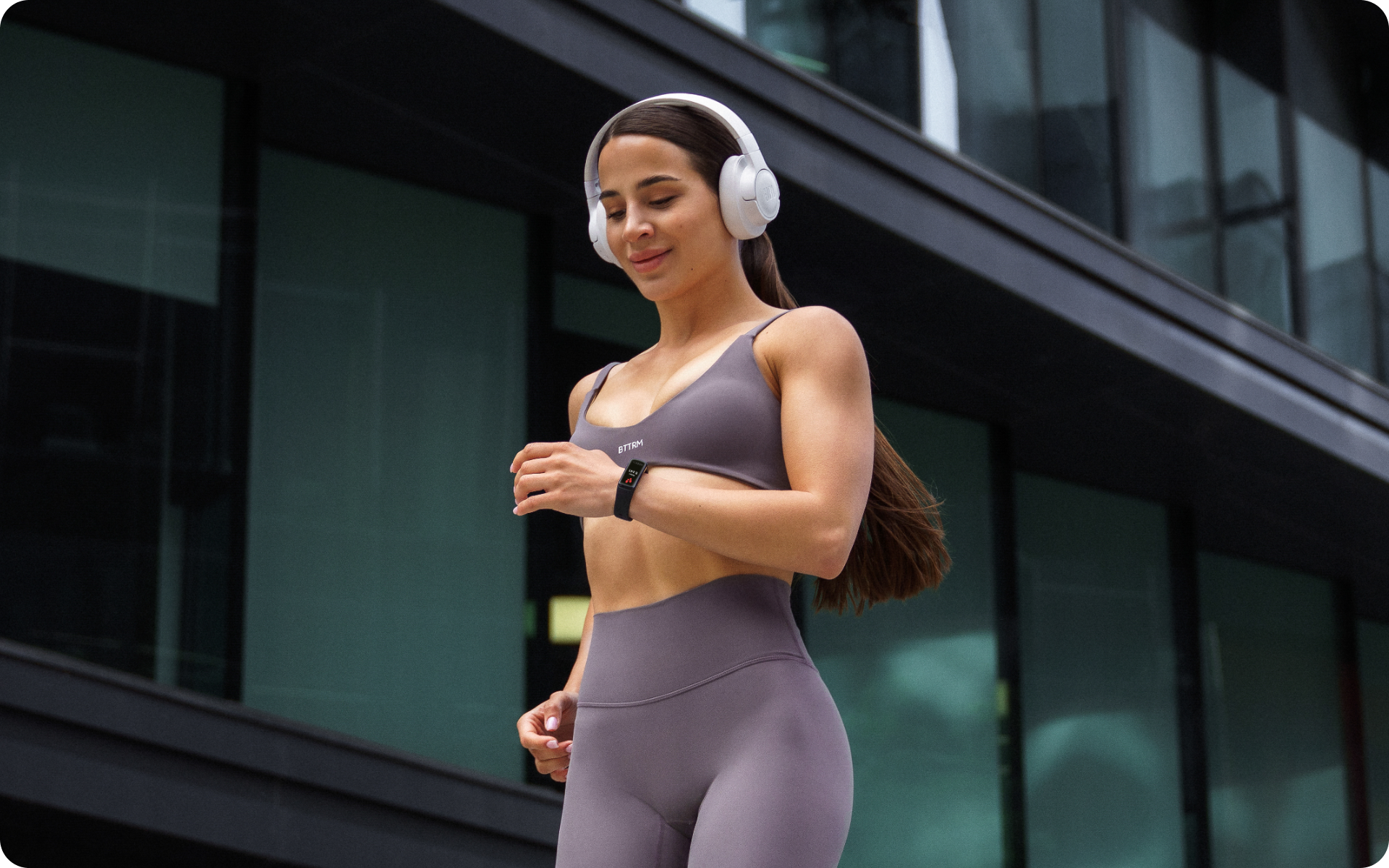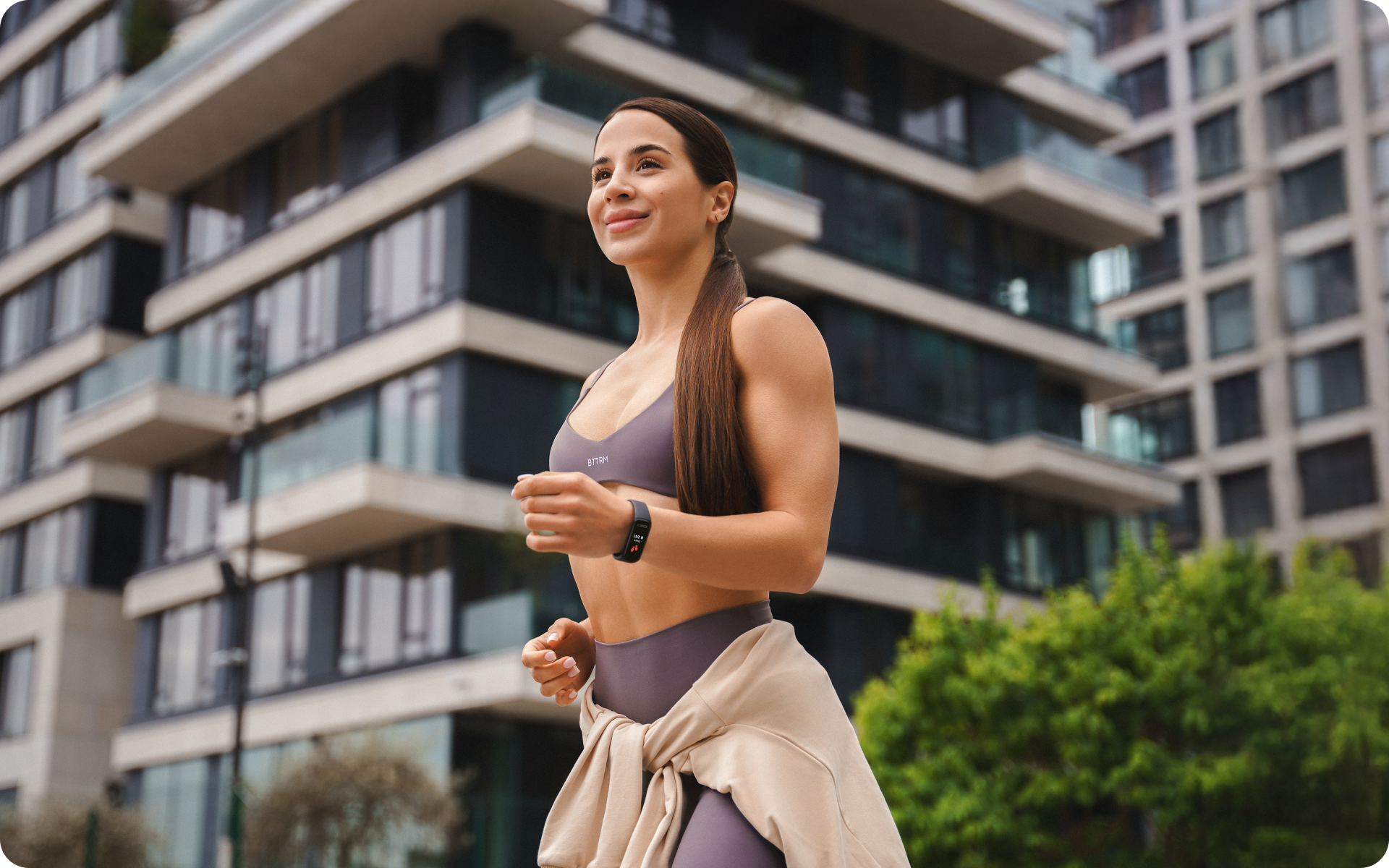When we think of walking, we think of a stroll in the park or a way to get from one place to another. However, walking is hardly the solution to our fitness woes.
Regardless, many of us could benefit from moving our bodies more.
A sedentary lifestyle can increase the risk of health problems such as:
- Obesity
- Heart disease
- Type 2 diabetes (1).
It’s no wonder the Centers for Disease Control and Prevention recommends that adults engage in at least 150 minutes of moderate-intensity aerobic activity, including walking, each week (2).
A straightforward way to increase the intensity of your walking routine is to incorporate weights.
The added strength challenge could be:
- Hand weights
- Ankle weights
- A weighted vest.
But before you grab your dumbbells and hit the pavement, it’s essential to understand the benefits, risks, and tips for walking with weights.
Is It A Good Idea To Walk With Weights?
Walking with weights can be an effective way to amplify your fitness routine.
It offers benefits such as increased calorie burn and improved muscle engagement but also has risks (3).
The Pros Of Walking With Weights
1. Boosted Calorie Burn
Adding weights increases the intensity of your walk, which can help you burn more calories in the same amount of time (4). Burning more calories is excellent to lose weight or maintain your current fitness level.
2. Improved Muscle Engagement
Hand or wrist weights encourage your arms and shoulders to work harder, while ankle weights can target your lower-body muscles.
Over time, this can lead to improved muscle strength.
3. Enhanced Cardiovascular Benefits
Weighted walking can give your cardiovascular system a more effective workout by slightly increasing your heart rate. It’s an easy way to make your walk a bit more challenging.
Weights add resistance, forcing your body to work harder and adapt over time.
The strength training boosts cardiovascular and muscular endurance, making tackling longer or more challenging walks easier. With consistent practice, you’ll notice that climbing steep hills or sustaining extended activities feels less exhausting.
4. Strengthened Bone Health
Weight-bearing activities contribute to stronger bones (5). Adding light weights to your walk may also help build bones, supporting long-term bone health as you age.
5. Improved Core Engagement
Incorporating weights into your walking routine can engage your core muscles to a greater extent.
As you carry the weights, your abdominal and back muscles stabilize your body to maintain proper form. Over time, this stabilization effort can contribute to improved core strength and stability.
6. Promotes Body Awareness
Walking with weights can help you better understand how your body moves.
Walking with hand weights exercises, ankle weights, or a weighted vest involves listening to your body’s signals.
Listening to your body means noticing when:
- It feels strong
- When you feel weak
- When you must make adjustments.
This heightened body awareness can prevent overexertion and minimize poor movement habits.
Read more: How Long Does It Take To Lose 45 Pounds By Walking?
The Cons Of Walking With Weights
1. Joint Strain
Extra weight can stress your joints, mainly your knees, hips, and ankles.
This joint strain could increase the risk of joint pain or injury if you’re not used to performing weighted exercises or have pre-existing joint pain or conditions.
2. Improper Technique Risks
Holding weights may alter your gait mechanics and exaggerate any compensations, which, if left uncorrected, can lead to overuse injuries.
Reasons why BetterMe is a safe bet: a wide range of calorie-blasting workouts, finger-licking recipes, 24/7 support, challenges that’ll keep you on your best game, and that just scratches the surface! Start using our app and watch the magic happen.
3. Higher Risk Of Injury
Heavier weights or jumping into a weighted walking routine too quickly can result in overexertion or injuries such as:
- Shin splints
- Tendon strain
- Pulled muscles
4. Less Focus On Walking Form
For some, adding weights can distract from perfecting walking posture and stride.
Improper form may reduce the overall benefits of exercise and increase the risk of injury.
Will Walking With Weights Tone Arms?
Walking with weights can gradually tone your arms.
Walking with dumbbells muscles worked:
- Walking with dumbbells and weights engages several forearm muscles involved with grip strength.
- The upper arms, back, chest, and shoulders have larger muscles for stability.
While this may increase grip strength, significant muscle hypertrophy is unlikely without additional strength training (6).
Activities like push-ups, dumbbell exercises, or resistance band routines are complements. Walking with weights is more effective for increasing endurance and grip strength than building substantial muscle mass.
Also, to see noticeable changes in muscle strength, size, and definition, it’s crucial to pair your workouts with proper rest, hydration, and a healthy diet (7).
Overall fitness influences muscle definition, so consider walking with weights as one component of your exercise plan rather than the sole focus.
How Long Should You Walk With Weights?
Deciding how long to walk with weights depends on your fitness level, the type and amount of weight used, and overall exercise goals.
Strike the right balance between pushing yourself and staying safe to avoid overexertion or injury (8).
Here’s how you can determine the ideal duration for your weighted walks.
Starting Duration For Beginners
If you’re new to walking with weights, it’s best to start conservatively.
Begin with short sessions lasting 10-15 minutes while using light weights, such as:
- 1-3 pounds per hand, ankle, or a 5-10-pound weighted vest.
- This light start will give your body time to adjust to the added resistance without undue strain on your joints or muscles.
You can complete the rest of your walk without weights to ensure you still meet your workout goals while minimizing fatigue.
Gradually Increasing Time
As your strength and endurance improve, gradually extend the time you carry weights during your walk.
- Over a few weeks, you can increase the duration by 5 minutes until you can complete a 30-minute walk.
- For a more advanced routine, you can work up to walking with weights for 45-60 minutes, provided you maintain proper form and feel comfortable.
Alternatively, you can break your walk into segments.
For instance, you should use weights for the middle portion of a 30-minute walk, allowing time at the beginning and end for lighter movements without added resistance.
Consider Your Goals
- Cardio Endurance and Fat Burn: If your primary focus is on burning calories and improving overall endurance, aim for 20-60-minute walks with light to moderate weights.
- Muscle Toning or Strength Building: To maximize muscle engagement, integrate arm—or leg-specific movements while walking for shorter durations (10-30 minutes) to minimize fatigue and ensure quality movements.
Types Of Weights To Consider
- Hand Weights
These engage the arms and shoulders but require more grip strength and endurance. - Ankle Weights
These will allow your hands to be free and not require any grip strength, but will also engage fewer muscles overall since the resistance is minimal. - Weighted Vests
These allow a more natural weight distribution while freeing your hands and legs.
Explore the benefits, risks, and beginner tips in our detailed guide – Walking With Weighted Vest.
Is Walking With Heavy Weights Good For You?
Walking with heavy weights can amplify your workout by increasing muscle engagement and calorie burn, but it’s not without risks. However, it can be a valuable addition to your fitness routine when done correctly and with proper precautions.
Ensure you lift weights that match your strength training level; otherwise, you can increase your risk of injury, particularly in your joints and lower back.
Here’s how to find the ideal weight for your walking routine:
1. Consider Your Fitness Level And Experience
- If you’re new to weighted walking:
Start with light weights (1-3 pounds per hand or a 5-10-pound vest). This weight helps your body adapt to the additional load without overloading your joints.
- More experienced individuals with established strength and stability:
Gradually progress to medium or heavier weights, such as the best hand weights for walking, 8-10-pounds, or a 20-pound weighted vest.
2. Align With Your Goals
- For Muscle Toning and Endurance:
Use moderate weights that challenge you without disrupting your natural stride. This balanced endurance helps engage your muscles without compromising your form.
- For Strength Building:
Incorporate heavier weights for shorter sessions to focus on resistance training.
Avoid long walks with heavy weights to reduce the risk of fatigue-related injuries.
3. Test The Weight
- When trying out a new weight, take a short walk (5-10 minutes) and assess how your body feels. The weight should be challenging but not cause discomfort or strain.
- Pay attention to how the weight affects your posture. If you feel yourself leaning forward, backward, or to the side, it’s likely too heavy.
- Keep your shoulders back, your core engaged, and your stride as natural as possible to prevent strain or injury.
4. Start Light And Progress Gradually
- Once you’ve mastered proper form with lighter weights, slowly increase the load in small increments (e.g., 1-2 pounds) every couple of weeks. This gradual progression allows your muscles and joints to adapt safely.
5. Listen To Your Body
- Stop if you experience pain or excessive fatigue during a weighted walk.
Over time, you’ll learn what your body can handle and when to scale back.
- If you’re unsure about selecting the right weight or proper technique, consult a fitness professional for personalized advice.
Read more: Walking 15 Minutes A Day Is Good For You And Here’s Why
What Happens If I Walk With Weights Everyday?
Daily walking with weights can be beneficial, but listening to your body and adjusting as needed is essential.
Here are some potential outcomes of daily weighted walks:
- Increased Muscle Definition: If your weight training goals include toning or building muscle, walking with weights every day can help you achieve those results faster.
- Improved Endurance: Regularly using weights during your walks can increase cardiovascular endurance by challenging your heart and lungs.
- Possible Joint Strain: Depending on the type and amount of weight used, daily walking with weights may strain the joints in your knees, hips, and ankles.
Use proper form and progressively increase the weight to avoid injuries.
- Potential For Overtraining: Give your body time to rest and recover.
Daily walking with weights may put you at risk of overtraining, leading to fatigue or injury.
Whether daily weighted walking suits you depends on the following:
- Your fitness level
- Your fitness goals
- How well your body responds to the added resistance.
So, Is It Better To Walk With Or Without Weights?
Whether walking with or without weights is better depends on your fitness goals, health considerations, and personal preferences.
When To Walk With Weights
- You Want to Build Strength or Tone Muscles:
Adding light weights while walking is excellent for engaging your arms, shoulders, and core, especially with intentional movements like curls or presses.
- You’re Short on Time: Weights can amplify your workout, helping you achieve more calorie burn and muscle engagement in a shorter window.
- You Have a Specific Fitness Goal: Weights can help if your priority is building endurance or adding resistance training to your walking routine.
When To Walk Without Weights
- You’re Focused on Cardiovascular Health: Long, steady walks without weights are ideal for improving heart health without overloading your muscles or joints.
- You Have Joint Concerns: Walking without weights minimizes stress on your hips, knees, and back, making it a safer option.
- You’re Just Starting: If you’re new to exercise, walking without weights lets you build a baseline of endurance and strength before incorporating resistance.
Whether you’re a workout beast or just a beginner making your first foray into the world of fitness and dieting – BetterMe has a lot to offer to both newbies and experts! Install the app and experience the versatility first-hand!
How To Decide What’s Best For You
- Assess Your Fitness Goals: If strength and toning are higher priorities, try walking with weights. For overall endurance or cardio health, go weight-free.
- Consider Your Health Conditions: Those with joint pain, arthritis, or back issues may benefit more from walking without weights to avoid unnecessary strain.
- Check Your Experience Level: Beginners should try walking without weights to master form and confidence before advancing to weighted routines.
- Adapt Based on Personal Preferences: Adding or removing weights from your walks doesn’t have to be an all-or-nothing approach. Depending on your energy level or daily goals, you can alternate between weighted and unweighted walks.
Walking with or without weights can contribute to overall fat loss, including arm fat, as it burns calories (9). Incorporating weights and targeted arm exercises during your walk to specifically tone your arms can help engage and strengthen arm muscles. However, spot reduction isn’t possible; fat loss occurs throughout the body. We discuss maximizing calorie burning using this simple exercise in our post – Calories Burned Walking 30 Minutes. No, most trainers and fitness experts advise against wearing wrist weights all day. Prolonged use can strain joints and muscles, potentially causing discomfort or injury. To avoid unnecessary stress, use wrist weights during specific workouts and remove them during daily activities. Yes, walking with weights can help tone your legs by engaging and strengthening the leg muscles, such as the quads, hamstrings, and calves. Adding ankle weights or using a weighted vest increases resistance, promoting muscle definition over time. We explore in greater detail how Walking With Ankle Weights Benefits your leg strength and helps sculpt these muscles. Yes, walking with weights benefits weight loss and helps burn more calories, which can contribute to fat loss when combined with a healthy diet (10). The added resistance from weights increases energy expenditure, making your workout more effective at burning fat than unweighted walking.Frequently Asked Questions
Can I lose arm fat by walking?
Is it good to wear wrist weights all day?
Does walking with weights tone legs?
Does walking with weights burn more fat?
The Bottom Line
Walking with or without weights offers distinct benefits, and the decision depends on your unique needs.
Adding weights can make your walk more challenging, boosting calorie burn and muscle engagement, but it comes with risks of overuse injury if not adequately prepared for or if overdone. Walking without weights is gentler, promotes natural movement, and is excellent for beginners or longer sessions. Ultimately, finding the balance that works for you—and listening to your body—is key.
DISCLAIMER:
This article is intended for general informational purposes only and does not serve to address individual circumstances. It is not a substitute for professional advice or help and should not be relied on for making any kind of decision-making. Any action taken as a direct or indirect result of the information in this article is entirely at your own risk and is your sole responsibility.
BetterMe, its content staff, and its medical advisors accept no responsibility for inaccuracies, errors, misstatements, inconsistencies, or omissions and specifically disclaim any liability, loss or risk, personal, professional or otherwise, which may be incurred as a consequence, directly or indirectly, of the use and/or application of any content.
You should always seek the advice of your physician or other qualified health provider with any questions you may have regarding a medical condition or your specific situation. Never disregard professional medical advice or delay seeking it because of BetterMe content. If you suspect or think you may have a medical emergency, call your doctor.
SOURCES:
- Sedentary Lifestyle: Overview of Updated Evidence of Potential Health Risks (2020, Ncbi.nlm.nih.gov)
- Adult Activity: An Overview | Physical Activity Basics (2023, cdc.gov)
- What Do Wrist Weights Help You Do? (n.d., livestrong.com)
- Effects of walking with hand-held weights on energy expenditure and excess postexercise oxygen consumption (2017, ncbi.nlm.nih.gov)
- Exercise and Bone Health (2020, orthoinfo.aaos.org)
- Strength training: Get stronger, leaner, healthier (2023, mayoclinic.org)
- 5 nutrition tips to maximize your workouts (2023, mayoclinichealthsystem.org)
- Wearable weights: How they can help or hurt (2021, health.harvard.edu)
- Walking: Trim your waistline, improve your health (2024, mayoclinic.org)
- Weight loss – a healthy approach (2024, betterhealth.vic.gov.au)
